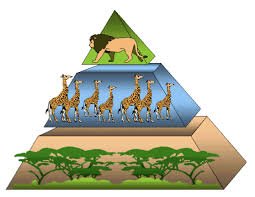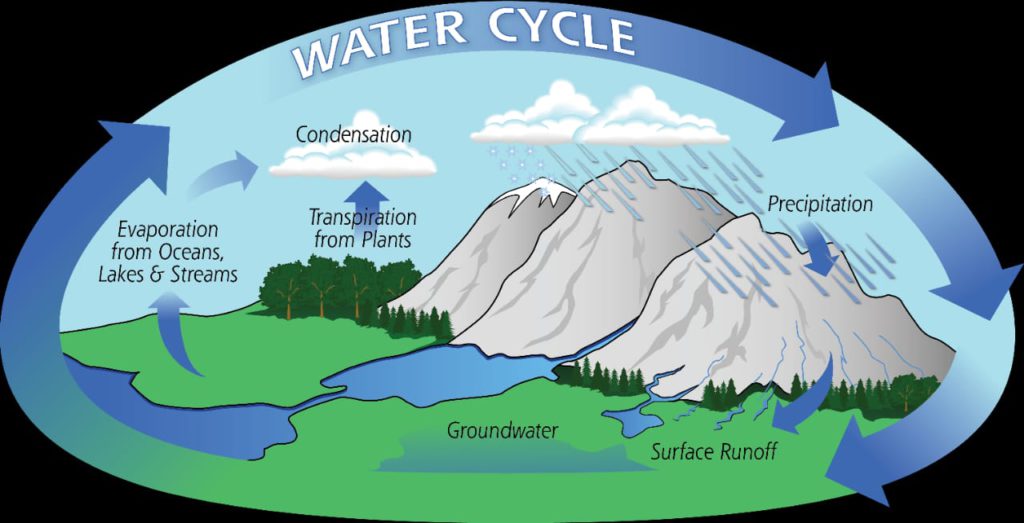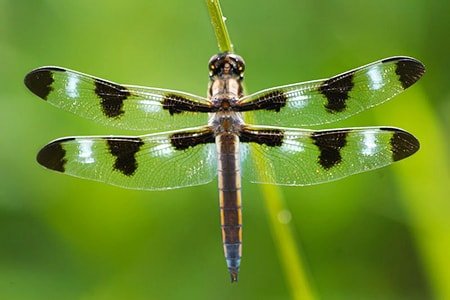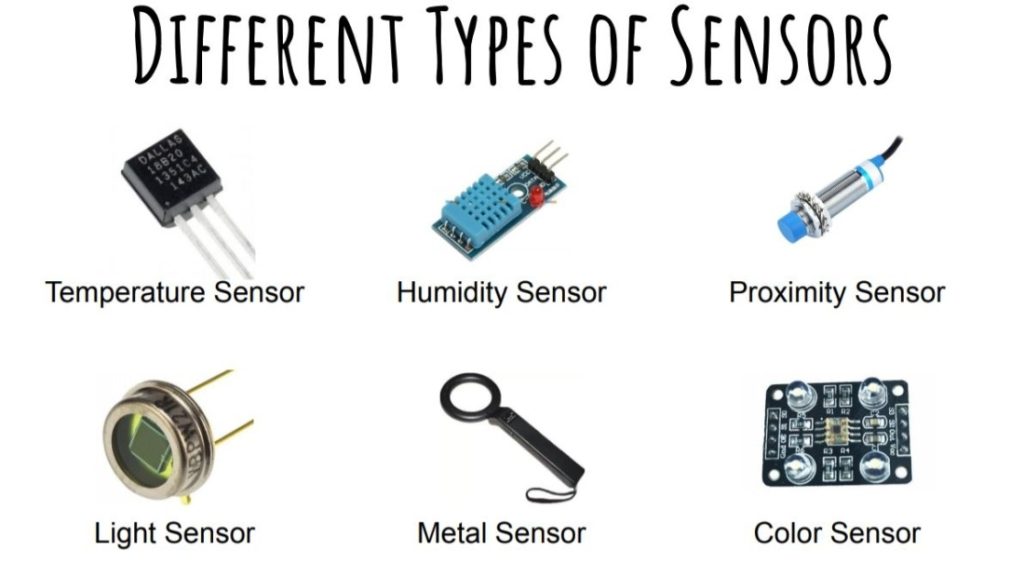Frogs typically live 3 to 18 years in the wild and 10 to 20 years in captivity. During these 20 years, each frog will go through a specific life cycle, which refers to the stages or changes that take place in an animal while alive. A frog passes through five developmental phases during which it grows and evolves. In this article we will look into each of these stages, that is, the entire life cycle of a frog in detail.
- Breeding in Frogs
- What happens after amplexus?
- What is metamorphosis?
- The five phases of the life cycle of a frog
- Stage 1: Fertilization of the eggs
- Stage 2: Tadpole
- Stage 3: Froglet
- Stage 4: Juvenile frog
- Stage 5: Adult Frog
- How is metamorphosis regulated?
- What external factors does metamorphosis depend on?
- Direct development of frogs
- Mechanism of direct development
- What are some benefits of normal metamorphosis over direct development?
- Summary of the life cycle of a frog
- FAQs
Breeding in Frogs
Let us begin by talking about breeding among frogs. Frog breeding season is often in the spring in temperate areas and during the rainy season in tropical climes. When male frogs are ready to procreate, they frequently utilise loud croaking sounds to attract a mate.

After attracting a female of the species, they begin to mate. When mating, the male frog grabs the female’s back and clasps his front legs around her waist or neck. Amplexus is the term that refers to this hug between the couple, and its objective is to put the male in the best position to fertilise the female’s eggs when she deposits them.
During amplexus, the male and female frogs are only together for a brief period of time, usually 20 minutes. This brief period of time includes their first encounter, the time it takes for the male to mount the female, and the time it takes for her to discharge all of her eggs and for the male to fertilise them.
It’s possible that the two frogs will mate again, but probably not to each other.
What happens after amplexus?
Frogs do not stay together to raise their young and frequently split up shortly after mating. Then, to safeguard her eggs until they hatch, the female frog may tie them to underwater plants or other materials. However, in a few species, such as the poison dart frog, the females forsake the eggs, but the males guard them until they hatch.
When the tadpoles hatch, they leave their eggs and go to a different location. The tadpoles then grow to become adult frogs via a process known as metamorphosis.
What is metamorphosis?
The changes that an animal undergoes during its life cycle are referred to as metamorphosis. During the metamorphosis of a frog, an egg hatches into a tadpole, which then develops its back legs first, then front legs, and eventually becomes a fully formed adult frog. Check out the video below to see how a frog grows during its life!
The five phases of the life cycle of a frog
Here we will look at each stage of the life cycle of a frog (as shown in the video above).

Stage 1: Fertilization of the eggs
The female frog’s pituitary gland detects the arrival of spring (the breeding season) by combining photoperiod (daylight hours) and temperature. In a sexually mature female frog, the pituitary gland secretes chemicals that induce the ovary to produce estrogen. Estrogen is a hormone that instructs the liver to produce and secrete yolk proteins, which are subsequently carried by the blood into the growing eggs of the ovary.
Simultaneously, progesterone, another ovarian hormone, instructs the egg to continue meiotic division. This is required because the egg freezes during the metaphase of its first meiosis. When the egg has finished its initial meiotic division, it is liberated from the ovary and is ready to be fertilised.
In many species, the eggs are encased in a jelly coat that serves to increase their size and protect them from infection. Furthermore, it also helps attract and activate sperm.
The process of fertilization

Fertilization occurs externally in the majority of frog species. As the female frog releases the eggs, the male frog clutches her back and fertilises them. Some species lay their eggs in pond vegetation, and the jelly sticks to the plants and holds the eggs in place. Other species just float their eggs into the centre of the pond.
Rana pipiens typically lays approximately 2500 eggs, but the bullfrog, Rana catesbiana, may lay up to 20,000 eggs.
Why does fertilization occur?
Fertilization fulfils a number of goals. Firstly, it permits the egg to complete its second meiotic division, resulting in a haploid pronucleus. The diploid zygotic nucleus is formed when the egg pronucleus and the sperm pronucleus meet in the egg cytoplasm. Secondly, fertilisation causes the cytoplasm of the egg to migrate, thus, various portions of the cytoplasm appear in new places. Thirdly, fertilisation initiates the cleavage and development of cells by activating the chemicals required for cell cleavage and development. Unless fertilisation happens, the sperm and egg perish.
What happens as the egg develops


The volume of the frog egg remains constant throughout cleavage, but it is split into tens of thousands of cells. The blastocoel, a fluid-filled chamber, originates in the mammalian hemisphere. This cavity will be critical for facilitating cell migration during gastrulation. Gastrulation refers to the process during this time, the blastula, a single-layered hollow sphere of cells) is rearranged into the gastrula (a multilayered structure).

In frogs, the process begins with the creation of a dimple termed the blastopore on the embryo surface, about 180 degrees opposite the location of sperm entrance. Cells go via the blastopore (a pit in the side of the embryo) toward the animal pole. These cells develop into the dorsal mesoderm (precursor of connective tissue, blood, skeleton, gonads, and kidneys), and the blastopore grows into a circle. The cells that migrate through the blastopore create the lateral and ventral mesoderm. On the other hand, the cells that remain on the exterior form the ectoderm (precursor of the epidermis and nerves), grow vegetative to encircle the entire embryo. The endoderm (precursor of the gut lining) is formed by the big yolky cells that stay in the vegetal hemisphere.
After gastrulation, the ectoderm is on the outside of the embryo, the endoderm on the inside, and the mesoderm is between them.
The process of organogenesis

Organogenesis, or the process during which the three germ tissue layers grow into the internal organs, begins once gastrulation is complete. It begins when the notochord, a rod of mesodermal cells in the embryo’s most dorsal region, form a tube and eventually become the nervous system. The embryo is known as a neurula at this stage.
The neural precursor cells stretch, lengthen and fold into the embryo, to form the neural tube. Additionally, the neural crest cells are the cells that link the neural tube to the epidermis. The neural crest cells function similarly to a fourth germ layer. They give birth to the pigment cells of the body (melanocytes), peripheral neurons, and facial cartilage.
Once the neural tube has developed, it causes modifications in its neighbours, resulting in the continuation of organogenesis. The mesodermal tissue around the notochord forms the somites, which are the predecessors of the back muscles, dermis, and spinal cord.
The embryo then grows a mouth and an anus before elongating into the classic tadpole shape. The neurons link with the muscles as well as other neurons, the gills develop, and finally, the larva emerges from the egg.
Frog eggs hatch between three and twenty-five days after they are deposited. The born tadpole will soon be able to feed itself after its mother’s yolk supply is depleted.
Stage 2: Tadpole
Tadpoles are the second stage of the frog’s life cycle. At this stage of its existence, the tadpole has no legs, so, it moves like a fish and breaths through its gills. The tadpole swims and consumes plants as well as algae from the water, and grows for several weeks.
Development of a tadpole
The transition of a tadpole larva into an adult frog is one of the most spectacular changes in all of biology. This development roughly takes 21 days.
In amphibians, hormones from the tadpole’s thyroid gland induce metamorphosis, and these changes prepare an aquatic creature for a terrestrial existence. Metamorphic alterations are quite noticeable in frogs and practically every organ is amenable to transformation. Furthermore, the variations in shape are rather noticeable.
Stage 3: Froglet
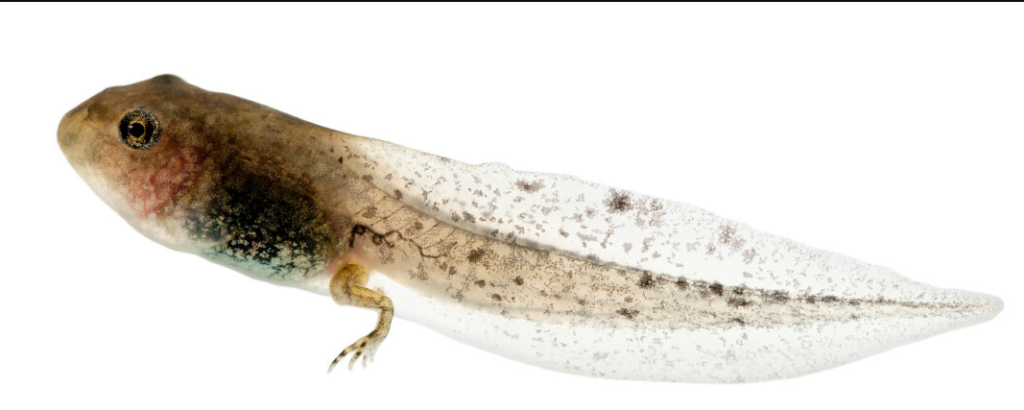
A froglet refers to a tadpole with legs.
Development of a tadpole into a frog
Firstly, the tadpole develops two hind legs and a lengthy body in addition to its head. Thus, instead of swimming, it can effortlessly bounce about with the aid of its two rear legs. The tadpole’s cartilaginous skull is replaced by the juvenile frog’s primarily bony skull. When the mouth and jaw change form and the frog’s fly-catching tongue muscle grows, the horny teeth that the tadpole uses to break pond plants vanish as well. Additionally, the big intestine of herbivores shortens to accommodate the adult frog’s more carnivorous diet. Then, the tadpole begins to build lungs, allowing it to breathe out of the water as it matures into a frog. With all of these modifications, the tadpole now resembles a little frog. However, despite the froglet’s resemblance to a frog, it still has a very long tail.
Stage 4: Juvenile frog

The froglet develops two front legs, and its lengthy tail shrinks in length. The tadpole feeds on the nutrients stored in its tail, so it doesn’t need to eat anything else until its tail is entirely gone.
Stage 5: Adult Frog

The frog’s tail will gradually vanish, and it will begin to consume insects rather than water plants. To become an adult, the juvenile frog will need to develop for around 2-4 years.
As metamorphosis comes to a close, the formation of the first germ cells occurs. Egg development can take around three years, after which, the frog becomes sexually mature.
How is metamorphosis regulated?
The thyroxin hormone regulates frog metamorphosis. During metamorphosis, the negative control of thyrotropin by thyroxine (T4) is loosened, allowing for increased whole-body T4 levels that allow for a particular tissue or cellular responses. Increased local thyroid cellular signalling results in cell-specific responses that result in localised developmental processes.
What external factors does metamorphosis depend on?
- The rate of transformation is precisely synchronised with environmental influences. In temperate climates, for example, transformation must occur before the pond freezes. Additionally, variations in developmental rates caused by the environment resulted in differences in relative hind leg length.
- A high food supplement causes tadpoles to grow quicker than those put on a low food supplement.
- Tadpoles grow faster in areas with lower water levels than in places with greater water levels.
- Tadpoles develop quicker in high population density settings than in low population density conditions.
Direct development of frogs
The development of an adult frog without advancement through an intermediate, morphologically different, free-living larval period is referred to as direct development. Surprisingly, this direct development does go through a thyroid hormone-dependent metamorphosis before hatching.
Several such alterations have been observed in the Puerto Rican tree frog, Eleutherodactylus coqui. Similarly, some frogs in the Western Ghats, about 52 species of Raorchestes and three species of Pseudophilautus, also bypass the tadpole stage altogether, emerging from their eggs as fully developed froglets that develop into adults. Another example of direct development is the Paedophryne amauensis, a Papua New Guinean microhylid frog.
Mechanism of direct development
The eggs of most direct developers are larger than 3 mm in diameter, as opposed to 1.3–1.8 mm in diameter eggs found in frogs with tadpoles. The early embryo appears as a collection of dorsal axial structures (neural tube, notochord, somites) lying on a ball of yolk. Furthermore, in contrast to the delayed origin and slow growth of limbs in tadpoles, direct developers exhibit early production of big limb buds. In addition, they have a frog-like head with huge eyes and a gaping mouth, as opposed to small eyes and a tadpole jaw optimised for rasping or filter-feeding.
Many structures found in aquatic embryos and tadpoles are primitive or do not form in direct development. Using E. coqui as an example, their embryos lack cement glands, which aquatic embryos employ to attach themselves to plants or other surfaces while developing swimming abilities. Additionally, gills are significantly decreased in E. coqui and completely eliminated in several other direct developers. The operculum’s development is also incomplete.
They do not produce lateral line organs, which aquatic species use to feel water currents, and their tail musculature is considerably decreased because the tail is no longer utilised for swimming.
The decrease or loss of all structures needed by tadpoles for eating and swimming eliminates one of the thyroid hormone’s regulatory activities, namely the destruction and resorption of tadpole-specific tissues. Thus, thyroid hormones only play an important role in the development of adult-specific structures.
You can obtain a more detailed insight into the direct development of frogs from the scientific article given below.
What are some benefits of normal metamorphosis over direct development?
Species that have maintained aquatic eggs and tadpoles may benefit in a variety of ways.
1. Allow females to produce more offspring and colonise areas with cooler and drier conditions.
2. Aquatic larvae frogs have bigger egg nests than direct-developing species. Their reproduction is designed to take advantage of increases in primary output to the greatest extent possible.
3. The longer a frog remains in the tadpole stage, eating and developing, the larger it will be when it eventually metamorphoses. Larger frogs can better evade predators and battle for territory and mates. Direct developers lose this advantage.
Summary of the life cycle of a frog
Frogs are amphibians, therefore they begin their life cycle as eggs and progress through five phases of development, with distinct features namely, eggs, tadpoles, froglets, juvenile frogs and adult frogs. A summary of each stage of the life cycle of the frog is mentioned in the table below.
| Stage | Name of life cycle | Notes |
| 1 | Eggs | Tiny fertilized eggs are laid in masses by the female frog, generally in water bodies. |
| 2 | Tadpole | A tadpole emerges from the egg. It resembles a fish as it possesses an elongated body with a long tail. Furthermore, the organism breadth through gills. |
| 3 | Froglet | The tadpole sprouts legs and develops lungs. However, it still has a tail |
| 4 | Juvenile frog | The tail reduces in size and the froglet begins to resemble an adult frog |
| 5 | Adult frog | The adult frog is fully developed and is capable of producing eggs of its own |
FAQs
1. Where do frogs lay their eggs?

Most frogs lay their eggs in the form of clusters, surface coatings, strings, or solitary eggs in calm water. The eggs can float freely in the water or be attached to sticks or submerged plants. Additionally, some frogs lay their eggs in streams, usually on the undersides of rocks. Some even have the habit of spreading the eggs as a film over the water’s surface, thus, allowing the eggs to mature in the most oxygenated section of the pool. This is seen in numerous groups of tree frogs in the American tropics, one of which, Smilisca baudinii, has been recorded to lay over 3,000 eggs.
Laying eggs on land
Many frogs also deposit their eggs on land and then move the tadpoles to water. Terrestrial eggs are laid by the ranid genus Sooglossus in the Seychelles islands and by all members of the family Dendrobatidae in the American tropics. Tadpoles attach to the backs of adults, generally males, after hatching. The frogs then transport the tadpoles to streams, bromeliads, or pools of water in logs or stumps, where they grow.
Development of eggs in vocal sac
The mouth-brooding frog, or Darwin’s frog, Rhinoderma darwinii, of southern South America, is a unique example of egg-laying and tadpole care. The female of the species lays 20 to 30 eggs on damp soil. Then, the male scoops up some eggs with his tongue when the eggs are close to hatch and the embryos are moving. The eggs enter via the vocal slits in his mouth floor and into the vocal sac. The larvae complete their development in the huge vocal sac after the eggs hatch. The newborn frogs emerge from the male’s mouth after transformation.
Laying eggs in bamboo
The Raorchestes species have remarkable parental behaviour. When it comes time to mate, Raorchestes chalazodes and Raorchestes ochlandrae frogs look for gaps, or holes, in the shoots of Ochlandra travancorica, an indigenous to the Western Ghats bamboo. They penetrate the bamboo stalks through existing insect-created openings, and once the eggs are placed, the female frog typically exits. The male frog, on the other hand, stays behind to protect the eggs, warding off predators and keeping them wet.
Breeding inside bamboos has been documented in several frog species in northeastern India, however, the chambers where the eggs are placed are filled with water in those techniques of reproduction, unlike in the case of the Raorchestes species.
2. What are the stages of metamorphosis?
(a) The pre-metamorphic stage
The stage is distinguished by significant growth and development of larval features, although transformation does not occur.
(b) Metamorphosis
The stage is distinguished by continuous growth, particularly limb development and the start of metamorphic processes.
(c) Climatic metamorphism
The stage is distinguished by significant changes in the larval traits, and the climax is defined by the disappearance of the majority of larval features.
3. Can metamorphosis occur in reverse?
If an animal advances in evolutionary grades during metamorphosis, the metamorphosis is termed progressive. So far, we have been discussing this type of metamorphosis, however, the process can also take place in reverse.
When metamorphosis occurs in a downward direction, the animal retrogresses or exhibits signs of degeneration. On the evolutionary scale, this is referred to as retrogressive metamorphosis. For example, Ascidia of urochordates or in neotenic forms such as salamanders.
Head towards Podium Blog to read about more such insightful topics.
Share with your friends

